Introduction
Previous studies have identified a strong desire for social connection in humans, with the levels and quality of social connection found to be important in shaping development across the life span, particularly in later life.
Recent research has shown that emotional closeness in relationships generally increases with age. However, ageing is normally associated with a decrease in the number of social relationships and an increase in social events that trigger significant disruptions to social ties (e.g., death of a parent, children leaving home, relocation, death of a spouse).
When and individual’s intimate and social needs are not adequately met, a complex set of feelings termed loneliness occur. Loneliness has been associated with a range of poor mental, physical and socio‑economic outcomes, including low self-esteem, suicide, depression, heart disease and poor physical health.
Relationships Australia first focussed on loneliness in the October 2014 monthly online survey by asking visitors to our website a series of questions about their levels of support. In the February 2017 survey, we asked visitors to our website to respond to a three-item scale that was designed to measure loneliness.
Previous research finds that…
- Women are more likely than men to report higher levels of social support.
- One in four women and one in three men report that they did not have someone to help them out if in need.
- Between 2001 and 2009 three out of ten Australians experienced loneliness.
- The proportion of people transitioning into, and out of, loneliness increased between 2001 and 2009, with 13 per cent experiencing repeat episodes of loneliness.
- People living in lone person and lone parent households were on average almost twice as likely to experience loneliness as people living in couple households, and couples with children were lonelier than couples without children.
Results
More than 1,980 people responded to the Relationships Australia online survey in January 2017. Around four in five survey respondents (78%) identified as female, with more females than males responding in every age group (figure 1). Eighty nine per cent of survey respondents were aged between 20‑59 years, and almost 45 per cent of respondents comprised women aged between 30-49 years (inclusive).
As for previous surveys, the demographic profile of survey respondents remains consistent with our experience of the groups of people that would be accessing the Relationships Australia website.
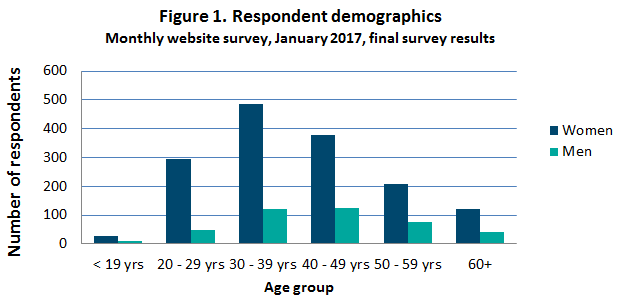
There were no significant differences in the reports of male and female survey respondents on the measures of loneliness (see figure 2).
More than one-third (34%) of male and female respondents reported that they often felt like they lacked companionship, while just under one-half (43%) reported that they sometimes lacked companionship.
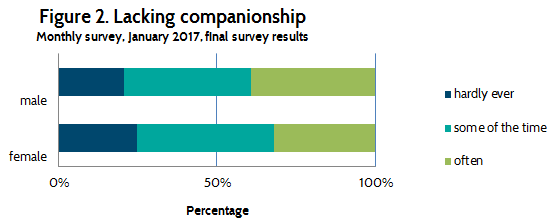
Fewer than one-quarter (24%) of survey respondents reported that they often felt left out, and an additional half (47%) reported that they sometimes felt left out (figure 3).
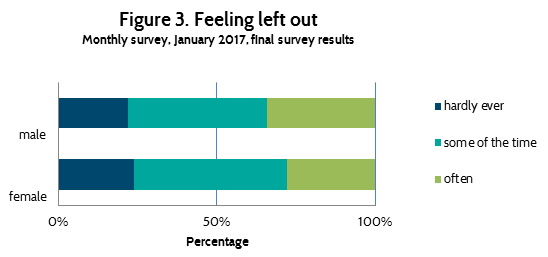
More than one-third (34%) of survey respondents reported that they often felt isolated, while around forty per cent (43%) reported that they felt isolated some of the time (figure 4).
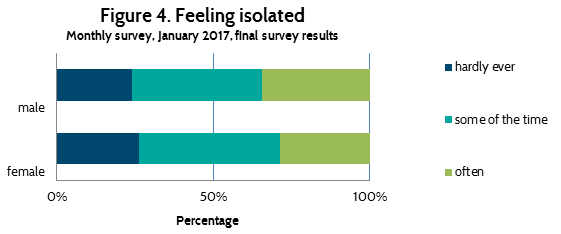
There were small but non-significant differences between the reports of men and women of different ages (Figure 5). These results contradict the findings of previous studies showing increased rates of loneliness for people of older ages. This most likely reflects the small number of people from older and younger ages that responded to the online survey.
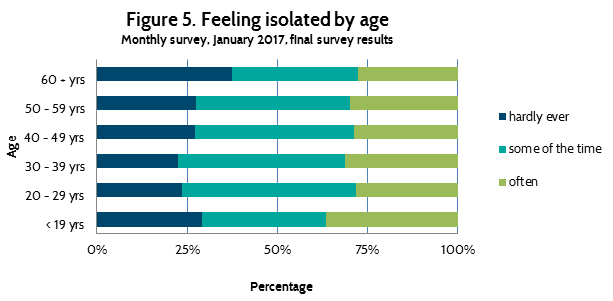
References
Baker, D. (2012). All the lonely people: Loneliness in Australia, 2001-2009, Institute Paper No. 9, June.
Baumeister, RF & Leary, MR. (1995). The Need to Belong: Desire for Interpersonal Attachment as a Fundamental
Human Motivation. Psychological Bulletin; 117:497–529.
Berry, HL & Shipley, M. (2009). Longing to belong: personal social capital and psychological distress in an Australian coastal region. Social Policy Research Paper No. 39. Canberra.
Fowler, HF & Christakis, NA.(2008). Dynanmic spread of happiness in a large social network: longitudinal analysis over 20 years in the Framingham Heart Study. BMJ, online first.
Hughes, ME, Waite, LJ, Hawkley, L. C. & Cacioppo, J, T. (2004). A Short Scale for Measuring Loneliness in Large Surveys: Results From Two Population-Based Studies. Res Aging. 26(6): 655‑672.
Hawkley, LC, Browne, MW & Cacioppo, JT. (2005). How Can I Connect With Thee? Let Me Count the Ways, Psychological Science, 16(10):798-804.
Resources and Credits
Thinking about loneliness and isolation can be distressing (will change a bit depending on the wording of the question). If you would like to talk to someone now you can contact:
- Kids Helpline – a counselling service for kids and young people. Call 1800 55 1800.
- Lifeline – a free crisis telephone counselling service. Call 13 11 14.
You might be interested in Neighbour Day to get ideas for making connections in your neighbourhood. www.neighbourday.org
You might also want to think about other ways to get more connected to you community, including
- volunteering
www.govolunteer.com.au
www.volunteer.com.au
www.volunteeringaustralia.org
- interest-based activities.
You can find out more about interest groups and recreational activities in your area from your local library, from local newspapers and through online searches. You can also think about joining in activities at your children’s school or offering your skills to local groups, or polishing up on your interests or learning something new through adult education courses.
Reference: Hughes, M. E, Waite, L. J, Hawkley, L. C & Cacioppo, J. T, (2004), A Short Scale for Measuring Loneliness in Large Surveys: Results From Two Population-Based Studies, Res Aging. 26(6): 655-672.
